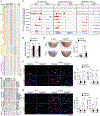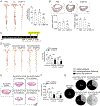Endothelial TGF-β signalling drives vascular inflammation and atherosclerosis
- PMID: 31572976
- PMCID: PMC6767930
- DOI: 10.1038/s42255-019-0102-3
Endothelial TGF-β signalling drives vascular inflammation and atherosclerosis
Abstract
Atherosclerosis is a progressive vascular disease triggered by interplay between abnormal shear stress and endothelial lipid retention. A combination of these and, potentially, other factors leads to a chronic inflammatory response in the vessel wall, which is thought to be responsible for disease progression characterized by a buildup of atherosclerotic plaques. Yet molecular events responsible for maintenance of plaque inflammation and plaque growth have not been fully defined. Here we show that endothelial TGFβ signaling is one of the primary drivers of atherosclerosis-associated vascular inflammation. Inhibition of endothelial TGFβ signaling in hyperlipidemic mice reduces vessel wall inflammation and vascular permeability and leads to arrest of disease progression and regression of established lesions. These pro-inflammatory effects of endothelial TGFβ signaling are in stark contrast with its effects in other cell types and identify it as an important driver of atherosclerotic plaque growth and show the potential of cell-type specific therapeutic intervention aimed at control of this disease.
Figures






Comment in
-
Resilience, disease and the age of single cell science.Aging (Albany NY). 2020 Feb 10;12(3):2028-2029. doi: 10.18632/aging.102850. Epub 2020 Feb 10. Aging (Albany NY). 2020. PMID: 32039835 Free PMC article. No abstract available.
References
Publication types
MeSH terms
Substances
Grants and funding
LinkOut - more resources
Full Text Sources
Medical
Molecular Biology Databases

